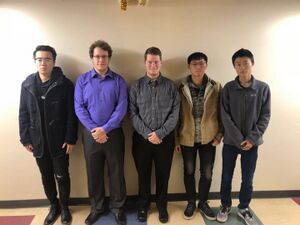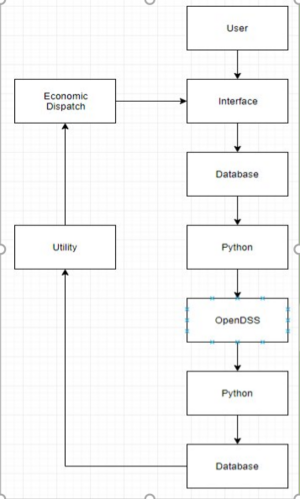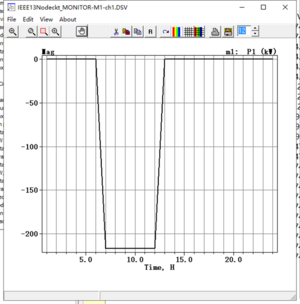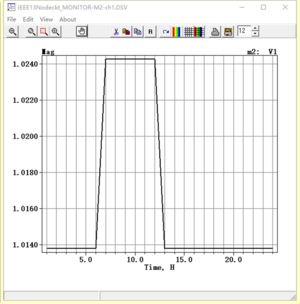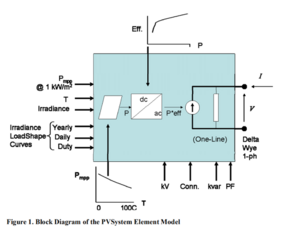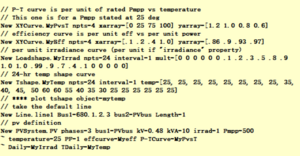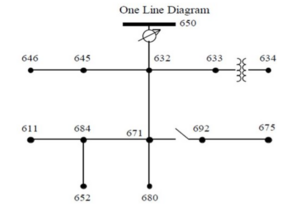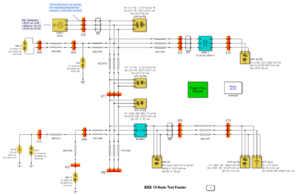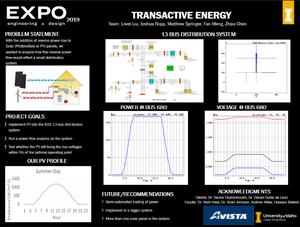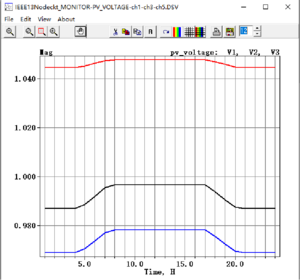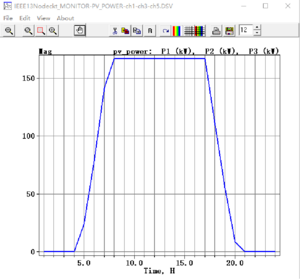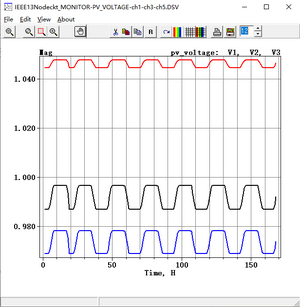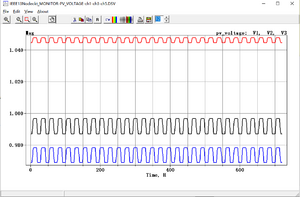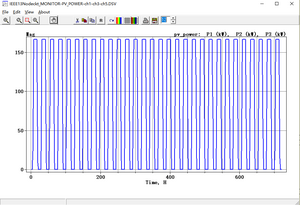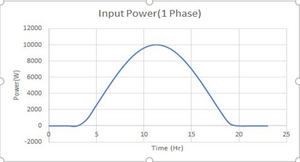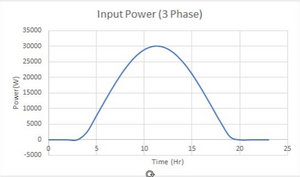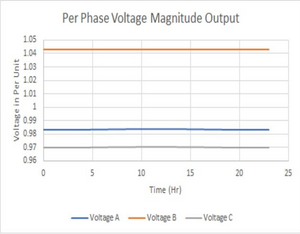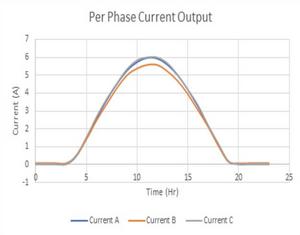Transactional Energy
| [[File:|300px|center|alt=]] | |
| Sponsors | Avista |
| Team Name | Prosumers are the Way |
| Duration | Fall 2018 - Spring 2019 |
| Faculty Adviser |
|
| Mentor |
|
| Client |
|
| Team Members |
|
The goal of the project is Design a small-scale simulated model of the power distribution network and analyze the impact of allowing consumers to inject power into the grid. This is the first step to develop electricity markets at the distribution system level and incorporating prosumers as providers within the public utility system.
Problem Definition[edit | edit source]
Project Goals[edit | edit source]
- Implement PV into IEEE 13 bus distribution system
- Run a power flow analysis on the system
- Test whether the PV will bring the bus voltage within 5% of the optimal operating point
Background[edit | edit source]
In the modern power grid, consumers are transforming into the so-called prosumers where electric power end-users could also generate their own energy from renewable resources such rooftop photovoltaic panels (PVs) or have stored energy in batteries (electric vehicle) and inject it back into the grid to sell the excess energy. This results in reverse power flows that could have an impact on the stability and the economics of the operation of the power distribution and transmission systems. The power distribution system could benefit from this local distributed generation if the adequate controls and sensing are developed.
Benefits[edit | edit source]
- Data analytics to increase efficiency in the distribution
- Profitable electric power pricing for Avista and the prosumer
- Possible of semi-automated trading of power
Soffware[edit | edit source]
The OpenDSS is a comprehensive electrical power system simulation tool primarly for electric utility power distribution systems. It supports nearly all frequency domain (sinusoidal steady‐state) analyses commonly performed on electric utility power distribution systems. In addition, it supports many new types of analyses that are designed to meet future needs related to smart grid, grid modernization, and renewable energy research. The OpenDSS tool has been used since 1997 in support of various research and consulting projects requiring distribution system analysis. Many of the features found in the program were originally intended to support the analysis of distributed generation interconnected to utility distribution systems and that continues to be a common use. Other features support analysis of such things as energy efficiency in power delivery and harmonic current flow. The OpenDSS is designed to be indefinitely expandable so that it can be easily modified to meet future needs. [[2]]
- OpenDSS Implementation
- Analysis of the System One day, week, and month profile to simulate a summer and winter scenario.See how the system reacts to these power output changes. Currently doing research on the best way to analyze the distribution system.
- OpenDSS Progress Made attempts to implement the PV profile into the system to see if we can get the systems voltages to be within 5% of optimal operations.Learned how to plot the Power, Voltage, and Current over a specified time interval.
- OpenDSS Objectives Implement PV profile into the system to see how the distribution system reacts.Create Plots of the Power, Voltage, and Current of a specified node over a specified time interval.Export all Data to a CSV file to later be analyzed.
Simulink Implementation
- Reasons for using Simulink Comparison with OpenDSS since we can implement the same PV profile.We can model the system to get better looking graphics for understanding the system.
- Future Plans with Simulink Incorporating the same PV Profile used in the OpenDSS part.Plot the profiles to see how they compare to OpenDSS.
- For simulink we found the same 13 bus distribution system that is being used in OpenDSS. We are using simulink mainly for a comparison, but also for the visuals so we can see what is being done to the system. Out first step was to try to learn and understand how simulink works. After we figured out how the software functions, we are then going to try and implement a PV module. This was proving to be an issue since all we tried was to put the module in the system and see how it works, but this was popping up plenty of errors the reason for this was most likely do to the fact that that we were putting DC current into an AC system.
PV[edit | edit source]
- Generate power through solar radiation given off by the sun.
- Clean Energy.
- Homeowners can use them to generate their own power.
- Must be in sunlight in order to work.
Figure 1 shows a schematic diagram of the PVSystem device model recently implemented into OpenDSS version 7.4.1 at Build 28.
Design Considerations[edit | edit source]
We propose to design, develop, test, and evaluate a software application that would enable prosumers and consumers to trade power on-demand or semi-automatically between themselves, with utility oversight, or with the utility. Such system would enable prosumer-consumer power trading with some of the characteristics of sharing economies and markets. Furthermore, the goal is that such system would lead, in the long run, to semi-automated trading of power similarly to current financial high-speed trading systems between smart-grid-enabled consumers, prosumers, and the utility. We will evaluate and select the best software technologies and design and develop a prototype software system that enables these transactions through an online web and/or app interface. Such system will enable Avista to create a new market for prosumer-consumer power trading and to plan, manage, and control such market and the flow of power through its network.
We will put the PV on bus 680.
- Created a PV profile for a summer and winter day, week, and month.
- Need to figure out what OpenDSS is going to read from the profile
- Then transform those csv values to the readable values
Product Requirements[edit | edit source]
- We are using OpenDSS to handle the modeling aspect of this project. The reason is, it's open source so we don't have to deal with licensing.The OpenDss Model needs to be changed dynamically.Since we are dealing with renewable energy, we will have to consider how to implement PV panels, EV's, and wind in our model.
- Wanted an analysis program free of licenses and did not cost us anything
- Wanted a program that could work with Matlab and Python
Schedule[edit | edit source]
Specific Project Plan The proposed tasks for the software effort are:
- T1: Meet with Avista® representatives to gather system requirements and understand information interchange interfaces such as to the Advanced Metering Infrastructure.
- T2: Design and model the system using modern system modeling tools such as ERD.
- T3: Develop the database architecture and schema and select a DBMS.T4: Analyze security risks and design and implement security mechanisms.
- T5: Develop a simulated model of the power distribution network.
- T6: Design and sketch Web and/or App interfaces: User and Administration.
- T7: Build the prototype software using a fourth-generation application development tool.
- T8: Integrate the transaction control system prototype with the distribution model.
- T9: Design and perform tests for: Functionality, Usability, and Security.
- T10: Produce user and administrator usage guides.
Proposed Project Schedule
- 01 September 2018 01 November 2018 01 January 2019 01 March 2019
- 01 June 2019 01 August 2019 31 August 2019
- Potential Market Path
- Project Kickoff. T1, T2, T3, T4, T5, T6, T7 start.
- T1, T2 complete. Initial prototype I.
- T3, T4, T5, T6 complete. T8 starts. Prototype refinement II. T7, T8 complete. T9 starts. Prototype refinement III.
- T8 complete. Prototype refinement IV.
- T9 complete. T10 starts. Final prototype refinement V.
- T10 complete and Final report.
Final Design[edit | edit source]
We want this model to be changed dynamically with adding varying loads and generators. We also want it to be able to communicate with the interface that is being created. We implemented PV profile into the system to see how the distribution system reacts and than created Plots of the Power, Voltage, and Current of a specified node over a specified time interval, finally, we exported all Data to a CSV file to later be analyzed.
Put monitor into the system to see how the system change
Simulation for a summer day in Opendss[edit | edit source]
Simulation for a summer week in Opendss[edit | edit source]
Simulation for a summer month in Opendss[edit | edit source]
Simulink Input Power[edit | edit source]
Voltage at bus 680[edit | edit source]
Current at bus 680[edit | edit source]
Conclusion[edit | edit source]
- After analysis, the resisential PV will not overload bus 680
- Phase B voltage on the bus is about 1% away from overloading the bus.
- This is a concern and will need to be watched when adding more PV panels to the system.
Validation[edit | edit source]
| Requirement | Test | Test subject | Target Date | Result | recommendation |
|---|---|---|---|---|---|
| The use of OpenDSS | Use the OpenDSS to support the design and operation of power distribution system | The power distribution system simulator | 10/22/2018 | We have just download the OpenDSS and begin to learn how to use it | Need more instructions about the OpenDSS |
| Doing more research by ourselves | Finishing the research including the requirements about software and other factors | The power distribution system simulator | 11/1/2018 | We have done a lot of researches on our own and I think it has enough time for us by the due time | Wikipedia is very useful for us |
| In progress | In progress | The power distribution system simulator | 11/8/2018 | We have done a lot of researches on our own and I think it has enough time for us by the due time | It just be in progress |
| compare OpenDss with Matllab | work on Matlab and 13 bus system | finish distribution system | 11/25/2018 | figure out what data we need for Matlab | Matlab is easier than OpenDss |
| Progress for OpenDss | combine the real time and reactive time | plan add model generator and storage | 12/12/2018 | we need to decrease the voltage | need some examples as reference to continue project |
| PV file from spokane and run system in different time | find all of PV profile | create a plot of OpenDss PV plan profiles | 01/11/2019 | schedule to 2 week report | the systen can't show load and energy |
| Focus on Power part and check how to add it | Get PV profile on website and run it | Find way to display data clearly | 01/16/2019 | show plot and coed in matlab | Allocate the mission for design review |
| put data from PV profiles in simulation | compare these data between OpenDss and simulink | Flow power level on | 03/20/2019 | pay more attention to documentation | check PV panel codes |
| plot PV graph and compare | make solar panel and compare | make simulink monthly | 04/05/2019 | opendss G can't work | select one in summer or winter to simulation |
| compare PV system between opendss and simulink | prepare source to write the final paper | simulink fail to attch PV profiles | 04/17/2019 | try to simulink long time period in OpenDss | put some power in Pvsystem |
Team Members[edit | edit source]
| Joshua Ropp
Major: Elecrtical Engineering
| |
| Matthew Springer
Major: Elecrtical Engineering
| |
| Zhiyu Chen
Major: Elecrtical Engineering
| |
| Liwei Liu
Major: Elecrtical Engineering
| |
| Fan Meng
Major: Elecrtical Engineering
|
Additional Documentation[edit | edit source]
Opendss
File:OpenDSS Vocab Cheat Sheet.pdf
Team contract
Meeting Minutes
File:Team minutes.pdf
File:Team minutes2.pdf
Presentations
File:Transpre.pdf
File:Snapshot Day1.pdf
File:Snapshot Day2.pdf
File:Snapshot Day3.pdf
Research Articles
File:A three-phase state estimation in active distribu.pdf
File:CoSimulatorOfPowerAndCommNetworks.pdf
File:Two-Stage Residential Energy Management Considering Network Operational Constraints.pdf
